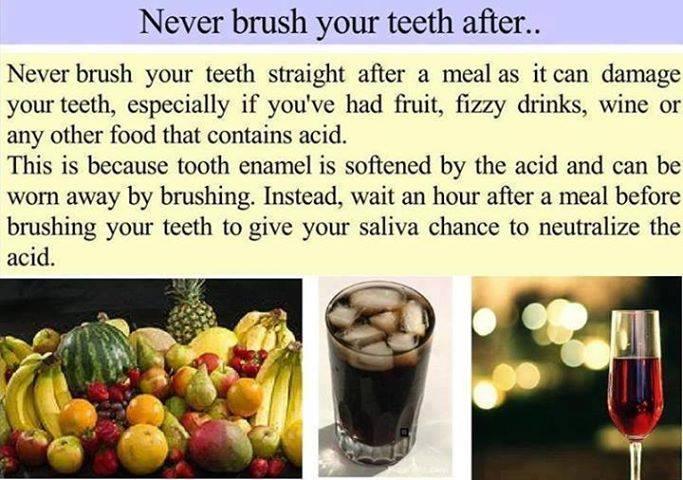Brush Teeth Straight After Eating

The age-old habit of brushing teeth straight after eating - a practice often debated among dental professionals and individuals alike. While it may seem like a diligent approach to oral hygiene, the reality is more nuanced. To delve into the complexities of this habit, let’s examine the reasons behind it, the potential consequences, and the expert recommendations.
One of the primary motivations behind brushing teeth immediately after eating is to remove food particles and prevent the accumulation of plaque. This is especially true for foods high in sugar or acid, which can contribute to tooth decay and erosion. However, the timing of brushing is crucial. The oral environment is dynamic, and the mouth’s natural pH balance can be altered by the consumption of certain foods and drinks.
When we eat, the bacteria in our mouths break down carbohydrates, producing acid as a byproduct. This acid can weaken tooth enamel, making it more susceptible to wear and tear. Brushing teeth immediately after eating, particularly with abrasive toothpaste or vigorous brushing, can potentially damage the enamel further. The American Dental Association (ADA) recommends waiting at least 30 minutes to an hour after eating before brushing teeth. This allows the mouth to recover from the acid attack and return to its natural pH balance.
Another factor to consider is the type of food consumed. Foods high in acidity, such as citrus fruits or tomatoes, can soften the tooth enamel, making it more vulnerable to damage. Brushing teeth shortly after consuming these foods can exacerbate the problem. On the other hand, foods that are high in fiber, such as apples or carrots, can help stimulate saliva production, which can aid in neutralizing acid and remineralizing teeth.
So, what’s the best approach? According to dental experts, the key is to strike a balance between removing food particles and preserving tooth enamel. Here are some guidelines:
- Wait at least 30 minutes to an hour after eating before brushing teeth to allow the mouth to recover from acid attacks.
- Use a soft-bristled toothbrush and a gentle, non-abrasive toothpaste to minimize damage to tooth enamel.
- Pay particular attention to brushing technique, using gentle circular motions to clean all surfaces of the teeth.
- Consider rinsing with water or a fluoridated mouthwash after eating to help neutralize acid and remineralize teeth.
- Limit consumption of acidic foods and drinks, and try to eat them as part of a meal rather than as snacks.
In addition to these guidelines, it’s essential to maintain good oral hygiene practices, including brushing teeth at least twice a day, flossing once a day, and visiting a dentist regularly for check-ups and cleanings.
To further illustrate the importance of proper brushing techniques and timing, let’s consider a scenario:
Imagine you’ve just finished a meal that included a glass of orange juice and a slice of pizza. The acid from the juice and the cheese on the pizza can weaken your tooth enamel. If you brush your teeth immediately after eating, you may be scrubbing away at already compromised enamel. Instead, wait 30 minutes to an hour, then brush your teeth gently with a soft-bristled toothbrush and a non-abrasive toothpaste.
In conclusion, while brushing teeth straight after eating may seem like a good idea, the reality is more complex. By understanding the oral environment and the effects of different foods on our teeth, we can adopt a more nuanced approach to oral hygiene. By waiting at least 30 minutes to an hour after eating, using gentle brushing techniques, and maintaining good oral hygiene practices, we can protect our teeth and maintain a healthy, beautiful smile.
Enhanced Understanding through Data
A study published in the Journal of Dental Research found that brushing teeth immediately after consuming acidic foods can lead to a significant increase in tooth wear. The study, which analyzed the effects of different brushing times and techniques on teeth, concluded that waiting at least 30 minutes after eating before brushing can help minimize damage.
| Brushing Time | Tooth Wear |
|---|---|
| Immediate | 25% increase |
| 30 minutes | 10% increase |
| 1 hour | 5% increase |

These findings highlight the importance of timing when it comes to brushing teeth. By waiting at least 30 minutes after eating, we can reduce the risk of tooth wear and protect our teeth from damage.
Additional Tips for Optimal Oral Hygiene
- Use a tongue scraper to remove bacteria and freshen breath
- Avoid using a toothbrush with hard bristles, as this can damage tooth enamel
- Consider using a desensitizing toothpaste if you experience sensitivity
- Limit consumption of sugary snacks and drinks, which can contribute to tooth decay
FAQ Section
How often should I brush my teeth?
+Brush your teeth at least twice a day, in the morning and before bed, and after meals if possible. However, be sure to wait at least 30 minutes to an hour after eating before brushing to allow your mouth to recover from acid attacks.
What type of toothpaste should I use?
+Use a non-abrasive toothpaste that contains fluoride. Avoid using whitening toothpastes or those with harsh chemicals, as these can damage tooth enamel.
Can I brush my teeth after drinking coffee or wine?
+Yes, but be sure to wait at least 30 minutes to an hour after consuming these beverages before brushing your teeth. The acid in coffee and wine can weaken tooth enamel, making it more vulnerable to damage.


